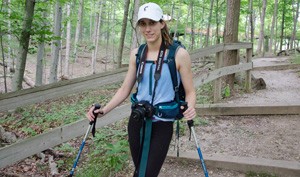
Architecture Student, Who Broke Her Back in Accident, Prepares to Climb Kilimanjaro
Four years ago, Katie Taylor was paralyzed from the waist down.
A skiing accident had left her with a broken back, and thats when, as a sophomore at Oakwood High School in Oakwood, Ohio, she was told she would likely never walk again.
But then, Taylor recounts, After about a month, I could move a toe. After another month, I actually stood up and shuffled. I still relied on a wheelchair for about three to four more months.
And, slowly, Taylor, who is today a 20-year-old sophomore majoring in architecture here at the University of Cincinnati, began her recovery, first getting around in a wheelchair, then on crutches and then with the help of a cane.
Right after my accident, I made a promise to myself to get better and to run a marathon, she recalls, adding that she was inspired by an article about Patrick Rummerfield, the first spinal cord injury quadriplegic in history to recover full physical mobility. Rummerfield was paralyzed from the neck down in his 20s, and 18 years later, he completed an Ironman triathlon.
And Taylor figures that climbing Mt. Kilimanjaro, the highest summit in Africa, comes close enough to her promised goal.
Taylor will hike the trail (no rock climbing is involved) to Uru Summit, taking about a week to reach that peak in early August, where she promises to have her picture taken with a UC pennant.
And, in some ways, she hopes her accident and subsequent slow recovery will be a plus in her endeavor: Ive been working on my cardio fitness and my leg strength with day-long hikes in Mt. Airy Forest or up the steps of Immaculata Church in Mt. Adams. I still have a slower pace because my recovery has been a slow one; however, in the thin mountain air of Kilimanjaro, its actually advised that the hikers take it slow, take small steps. Speed is not the way to complete this challenge, endurance is. Its actually advisable to walk slowly in order to gradually acclimatize to the altitude as you go.

Katie Taylor training for her Kilimanjaro climb.
Others with physical disabilities have completed this route (Machame Route) to climb Kilimanjaro. In Taylors case, she figures the hike will take a week, hiking eight hours a day.
She states, Ive been told by people that the temperature will be frigid and that the night before reaching Uru Summit is miserable but then you reach the peak as the sun is coming up, and everything is then worth it.
Taylor jokes that that kind of experience isnt unlike the challenges of being in UCs top-ranked programs within the College of Design, Architecture, Art, and Planning. She says, Well, DAAP is stressful, but there are also great opportunities like co-opping with a great firm. (Shes already had one such
in Pittsburgh, and is looking forward to her second
semester this fall in Baltimore.) Or, you ace a project or crit. Then, its all worth it.
Taylor, who will start her climb on Aug. 6 and return to Ohio on Aug. 14, hopes to raise awareness and funds by means of her climb. She explains, Its important not to put limits on what we think people with disabilities can or cannot do.
She is also raising funds for an organization called
, and you can see a video of Taylor on the organizations home page. The organization, headquartered here in Cincinnati, specializes in linking individuals with specific needs to skilled volunteers who can invent, modify or adapt devices that improve the quality of life for those with physical disabilities.
Accompanying Taylor on her hike are friends Eric Oberwise, an engineering student at the University of Dayton, and Chris Kubik, project director at May We Help.

Katie Taylor trains for her Kilimanjaro climb.
- Apply to UCs undergraduate architecture program.
Related Stories
Media coverage and word of mouth extends DAAP art exhibit to...
April 19, 2024
Due to popular draw, the art exhibit "Rediscovering Catharina van Hemessen’s Scourging of Christ: Women Artists, Patrons, and Rulers in Renaissance Europe" has been extended at the DAAP Library through April 30.
UC’s Ground Floor Makerspace births combat robots
April 17, 2024
In the heart of UC's 1819 Innovation Hub lies the Ground Floor Makerspace, an advanced and active hub of ingenuity where students, faculty and the community converge to bring their ideas to life. This includes being the birthplace of robots much like miniature race cars, combating fender to fender in an enclosed boxing ring. Combat robots like UC's Maximizer will again be fighting for first place in the National Havoc Robot League (NHRL) competition, slated for April 20.
UC President Neville Pinto shares 2024 State of the University...
April 16, 2024
University of Cincinnati President Neville G. Pinto shared his 2024 Sate of the University address with the campus community on April 15.
